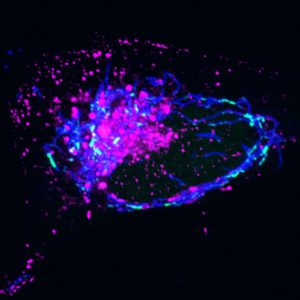
February 8, 2024
Salk scientists outline mouse cell inflammation pathway from mitochondrial stress to leaking endosomes to immune system initiation, revealing new potential therapeutic targets to reduce inflammation in aging and disease
Salk scientists outline mouse cell inflammation pathway from mitochondrial stress to leaking endosomes to immune system initiation, revealing new potential therapeutic targets to reduce inflammation in aging and disease
LA JOLLA—Cells in the human body contain power-generating mitochondria, each with their own mtDNA—a unique set of genetic instructions entirely separate from the cell’s nuclear DNA that mitochondria use to create life-giving energy. When mtDNA remains where it belongs (inside of mitochondria), it sustains both mitochondrial and cellular health—but when it goes where it doesn’t belong, it can initiate an immune response that promotes inflammation.

Now, Salk scientists and collaborators at UC San Diego have discovered a novel mechanism used to remove improperly functioning mtDNA from inside to outside the mitochondria. When this happens, the mtDNA gets flagged as foreign DNA and activates a cellular pathway normally used to promote inflammation to rid the cell of pathogens, like viruses.
The findings, published in Nature Cell Biology on February 8, 2024, offer many new targets for therapeutics to disrupt the inflammatory pathway and therefore mitigate inflammation during aging and diseases, like lupus or rheumatoid arthritis.
“We knew that mtDNA was escaping mitochondria, but how was still unclear,” says senior and co-corresponding author Professor Gerald Shadel, director of the San Diego-Nathan Shock Center of Excellence in the Basic Biology of Aging and holder of the Audrey Geisel Chair in Biomedical Science at Salk. “Using imaging and cell biology approaches, we’re able to trace the steps of the pathway for moving mtDNA out of the mitochondria, which we can now try to target with therapeutic interventions to hopefully prevent the resulting inflammation.”
One of the ways our cells respond to damage and infection is with what’s known as the innate immune system. While the innate immune response is the first line of defense against viruses, it can also respond to molecules the body makes that simply resemble pathogens—including misplaced mtDNA. This response can lead to chronic inflammation and contribute to human diseases and aging.

Scientists have been working to uncover how mtDNA leaves mitochondria and triggers the innate immune response, but the previously characterized pathways did not apply to the unique mtDNA stress conditions the Salk team was investigating. So, they turned to sophisticated imaging techniques to gather clues as to where and when things were going awry in those mitochondria.
"We had a huge breakthrough when we saw that mtDNA was inside of a mysterious membrane structure once it left mitochondria—after assembling all of the puzzle pieces, we realized that structure was an endosome,” says first author Laura Newman, former postdoctoral researcher in Shadel’s lab and current assistant professor at the University of Virginia. “That discovery eventually led us to the realization that the mtDNA was being disposed of and, in the process, some of it was leaking out.”
The team discovered a process beginning with a malfunction in mtDNA replication that caused mtDNA-containing protein masses called nucleoids to pile up inside of mitochondria. Noticing this malfunction, the cell then begins to remove the replication-halting nucleoids by transporting them to endosomes, a collection of organelles that sort and send cellular material for permanent removal. The endosome gets overloaded with these nucleoids, springs a leak, and mtDNA is suddenly loose in the cell. The cell flags that mtDNA as foreign DNA—the same way it flags a virus’s DNA—and initiates the DNA-sensing cGAS-STING pathway to cause inflammation.
“Using our cutting-edge imaging tools for probing mitochondria dynamics and mtDNA release, we have discovered an entirely novel release mechanism for mtDNA,” says co-corresponding author Uri Manor, former director of the Waitt Advanced Biophotonics Core at Salk and current assistant professor at UC San Diego. “There are so many follow-up questions we cannot wait to ask, like how other interactions between organelles control innate immune pathways, how different cell types release mtDNA, and how we can target this new pathway to reduce inflammation during disease and aging.”
The researchers hope to map out more of this complicated mtDNA-disposal and immune-activation pathway, including what biological circumstances—like mtDNA replication dysfunction and viral infection—are required to initiate the pathway and what downstream effects there may be on human health. They also see an opportunity for therapeutic innovation using this pathway, which represents a new cellular target to reduce inflammation.
Other authors include Sammy Weiser Novak, Gladys Rojas, Nimesha Tadepalle, Cara Schiavon, Christina Towers, Matthew Donnelly, Sagnika Ghosh, Sienna Rocha, and Ricardo Rodriguez-Enriquez of Salk; Danielle Grotjahn and Michaela Medina of The Scripps Research Institute; Marie-Ève Tremblay of the University of Victoria in Canada; Joshua Chevez of UC San Diego; and Ian Lemersal of the La Jolla Institute for Immunology.
The work was supported by the National Institutes of Health (R01 AR069876, P30AG068635, 1K99GM141482, 1F32GM137580, T32GM007198, 5R00CA245187, and 5R00CA245187-04S1), an Allen-AHA Initiative in Brain Health and Cognitive Impairment award (19PABH134610000H), a National Science Foundation NeuroNex Award (2014862), Chan-Zuckerberg Initiative Imaging Scientist Award, the LIFE Foundation, a George E. Hewitt Foundation for Medical Research Postdoctoral Fellowship, Paul F. Glenn Foundation for Medical Research Postdoctoral Fellowship, Salk Pioneer Fund Postdoctoral Scholar Award, the Waitt Foundation, Yale University School of Medicine Center for Cellular and Molecular Imaging, a Canada Research Chair (Tier 2) in Neurobiology of Aging and Cognition, and a Canada Foundation for Innovation John R. Evans Leaders Fund (grant 39965).
DOI: 10.1038/s41556-023-01343-1
JOURNAL
Nature Cell Biology
AUTHORS
Laura E. Newman, Sammy Weiser Novak, Gladys R. Rojas, Nimesha Tadepalle, Cara R. Schiavon, Danielle A. Grotjahn, Christina G. Towers, Marie-Ève Tremblay, Matthew P. Donnelly, Sagnika Ghosh, Michaela Medina, Sienna Rocha, Ricardo Rodriguez-Enriquez, Joshua A. Chevez, Ian Lemersal, Uri Manor, and Gerald S. Shadel
Office of Communications
Tel: (858) 453-4100
press@salk.edu
Unlocking the secrets of life itself is the driving force behind the Salk Institute. Our team of world-class, award-winning scientists pushes the boundaries of knowledge in areas such as neuroscience, cancer research, aging, immunobiology, plant biology, computational biology and more. Founded by Jonas Salk, developer of the first safe and effective polio vaccine, the Institute is an independent, nonprofit research organization and architectural landmark: small by choice, intimate by nature, and fearless in the face of any challenge.
Notifications